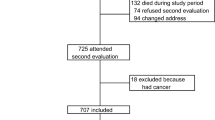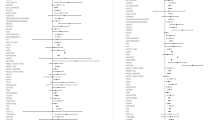Abstract
Summary
Non-hip, non-vertebral fractures (NHNVF) were compared with hip, vertebral and controls. NHNVF were younger and heavier than controls and hip/vertebral fractures in both men and women, respectively. Falls and prior fractures were less common in NHNVF than hip fractures. Glucocorticoid use was lower in NHNVF compared to vertebral fracture (VF) in men.
Introduction
Although hip fracture (HF) and vertebral fractures (VF) receive the most attention in the literature and are the targeted sites for fracture prevention, non-hip, non-vertebral fracture (NHNVF) sites account for a greater proportion of fractures than the hip or vertebrae. This study aimed to assess risk factors for NHNVF and compare them with those for HF, VF and controls.
Methods
Incident fractures during 2005–2007 for men and 1994–1996 for women were identified using computerised keyword searches of radiological reports, and controls were selected at random from electoral rolls for participation in the Geelong Osteoporosis Study. Participants aged 60+ years were included in this study.
Results
Compared to controls, men and women with NHNVF were younger (ORs, 0.90, 95 % CI 0.86–0.94; and 0.96, 0.93–0.98, respectively) and had a lower femoral neck bone mineral density (BMD) T-score (age-adjusted; difference [men] 0.383, P = 0.002; [women] 0.287, P = 0.001). Compared to HF, men and women with NHNVF were heavier (difference [men] 9.0 kg, P = 0.01; [women] 7.6 kg, P < 0.001). Heavier weight was also a risk factor for women with NHNVF compared to VF (1.03, 1.01–1.06). In men with NHNVF, falls (0.37, 0.14–0.97) and prior fractures (0.38, 0.15–0.98) were less common compared to HF; and glucocorticoid use was less common for NHNVF (0.30, 0.11–0.85) compared to VF.
Conclusions
Given the high numbers of NHNVF sustained by men and women in this study, fracture prevention strategies should focus on individuals with high risk of sustaining these types of fractures, as well as on individuals who are more likely to sustain a HF or VF.
Similar content being viewed by others
References
Tranah GJ, Taylor BC, Lui L-Y et al (2008) Genetic variation in candidate osteoporosis genes, bone mineral density, and fracture risk: the study of osteoporotic fractures. Calcif Tissue Int 83:155–166
Sanders KM, Seeman E, Ugoni AM, Pasco JA, Martin TJ, Skoric B, Nicholson GC, Kotowicz MA (1999) Age- and gender-specific rate of fractures in Australia: a population-based study. Osteoporos Int 10:240–247
van Staa TP, Dennison EM, Leufkens HGM, Cooper C (2001) Epidemiology of fractures in England and Wales. Bone 29:517–522
Gnudi S, Sitta E, Lisi L (2009) Relationship of body mass index with main limb fragility fractures in postmenopausal women. J Bone Miner Metab 27:479–484
Wearing SC, Hennig EM, Byrne NM, Steele JR, Hills AP (2006) Musculoskeletal disorders associated with obesity: a biomechanical perspective. Obes Rev 7:239–250
Prentice A (2004) Diet, nutrition and the prevention of osteoporosis. Public Health Nutr 7:227–243
FitzGerald G, Boonen S, Compston JE, Pfeilschifter J, LaCroix AZ, Jr DWH, Hooven FH, Gehlbach SH, Investigators G (2012) Differing risk profiles for individual fracture sites: evidence from the Global Longitudinal Study of Osteoporosis in Women (GLOW). J Bone Miner Res 27:1907–1915
Pasco JA, Nicholson GC, Kotowicz MA (2012) Cohort profile: Geelong Osteoporosis Study. Int J Epidemiol 41:1565–1575
Sanders KM, Pasco JA, Ugoni AM, Nicholson GC, Seeman E, Martin TJ, Skoric B, Panahi S, Kotowicz MA (1998) The exclusion of high trauma fractures may underestimate the prevalence of bone fragility fractures in the community: the Geelong Osteoporosis Study. J Bone Miner Res 13:1337–1342
Pasco JA, Nicholson GC, Henry MJ, Kotowicz MA, Gaudry TM (1999) Identification of incident fractures: the Geelong Osteoporosis Study. Aust N Z J Med 29:203–206
Monagle S (2002) Reducing falls in community dwelling elderly. Aust Fam Physician 31:1111–1115
Smith JA, Braunack-Mayer A, Wittert G, Warin M (2007) “I've been independent for so damn long!”: independence, masculinity and aging in a help seeking context. J Aging Stud 21:325–335
Bell AJ, Talbot-Stern JK, Hennessy A (2000) Characteristics and outcomes of older patients presenting to the emergency department after a fall: a retrospective analysis. Med J Aust 173:179–182
Thorell K, Ranstad K, Midlöv P, Borgquist L, Halling A (2014) Is use of fall risk-increasing drugs in an elderly population associated with an increased risk of hip fracture, after adjustment for multimorbidity level: a cohort study. BMC Geriatr 14:131
Cooley H, Jones G (2001) A population-based study of fracture incidence in southern Tasmania: lifetime fracture risk and evidence for geographic variations within the same country. Osteoporos Int 12:124–130
Henry MJ, Pasco JA, Sanders KM, Nicholson GC, Kotowicz MA (2006) Fracture risk (FRISK) score: Geelong Osteoporosis Study. Radiology 241:190–196
World Health Organization Collaborating Centre for Metabolic Bone Diseases University of Sheffield UK (2011) FRAX ® WHO Fracture Risk Assessment Tool. http://www.shef.ac.uk/FRAX/ Accessed 1st October 2013 1st October 2013
Nielson CM, Marshall LM, Adams AL, LeBlanc ES, Cawthon PM, Ensrud K, Stefanick ML, Barrett-Connor E, Orwoll ES (2011) BMI and fracture risk in older men: the osteoporotic fractures in men study (MrOS). J Bone Miner Res 26:496–502
Greco EA, Fornari R, Rossi F et al (2010) Is obesity protective for osteoporosis? Evaluation of bone mineral density in individuals with high body mass index. Int J Clin Pract 64:817–820
Sukumar D, Schlussel Y, Riedt CS, Gordon C, Stahl T, Shapses SA (2011) Obesity alters cortical and trabecular bone density and geometry in women. Osteoporos Int 22:635–645
Johansson H, Kanis JA, Odén A et al (2013) A meta-analysis of the association of fracture risk and body mass index in women. J Bone Miner Res 29:223–233
Compston JE, Watts NB, Chapurlat R et al (2011) Obesity is not protective against fracture in postmenopausal women: GLOW. Am J Med 124:1043–1050
Edwards MH, Jameson K, Denison H, Harvey NC, Sayer AA, Dennison EM, Cooper C (2013) Clinical risk factors, bone density and fall history in the prediction of incident fracture among men and women. Bone 52:541–547
Villareal DT, Banks M, Siener C, Sinacore DR, Klein S (2004) Physical frailty and body composition in obese elderly men and women. Obes Res 12:913–920
Pasco J, Henry M, Merriman E, Nicholson G, Kotowicz M (2004) The heavier they are, the harder they fall? ANZBMS Annual Conference Hunter Valley, NSW, Australia
Michaëlsson K, Wolk A, Langenskiöld S, Basu S, Lemming EW, Melhus H, Byberg L (2014) Milk intake and risk of mortality and fractures in women and men: cohort studies. BMJ 349:g6015
Chu SP, Kelsey JL, Keegan THM, Sternfeld B, Prill M, Quesenberry CP, Sidney S (2004) Risk factors for proximal humerus fracture. Am J Epidemiol 160:360–367
Holloway K, Brennan S, Kotowicz M, Bucki-Smith G, Dobbins A, Timney E, Williams L, JA P (2015) Age- and sex-related patterns of first fracture and fracture prevalence. Calcif Tissue Int 96:38–44
Acknowledgments
The study was supported by the National Health and Medical Research Council (NHMRC) Australia and Amgen Europe (GmBH); however, the funding bodies played no part in the design or conduct of the study, the collection, management, analysis and interpretation of the data or in the preparation or review of the manuscript. SLB-O is supported by an Alfred Deakin Postdoctoral Research Fellowship (2015-16).
Conflicts of interest
None.
Author information
Authors and Affiliations
Corresponding author
Rights and permissions
About this article
Cite this article
Holloway, K.L., Henry, M.J., Brennan-Olsen, S.L. et al. Non-hip and non-vertebral fractures: the neglected fracture sites. Osteoporos Int 27, 905–913 (2016). https://doi.org/10.1007/s00198-015-3322-8
Received:
Accepted:
Published:
Issue Date:
DOI: https://doi.org/10.1007/s00198-015-3322-8




